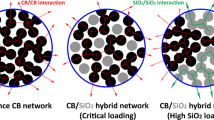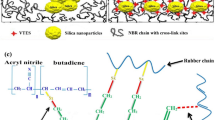Abstract
In this research, the effects of the surface modification of silica by low-molecular-weight hydroxyl-terminated polybutadiene (HTPB) are compared with those of bis(3-triethoxysilylpropyl)tetrasulfide (TESPT) on the mechanical, viscoelastic, and tribological properties of styrene-butadiene rubber (SBR) vulcanizates. Both modifiers have the ability to make covalent bonds with the rubber matrix, but with different interfacial characteristics controlling the final properties. The results displayed improvements in the tribological behavior of both modified silica-filled vulcanizates over pristine silica- and carbon black-filled vulcanizates. However, the HTPB modification method, despite providing a finer dispersion of the silica in the rubber, did not result in better tribological properties for the vulcanizates compared with those of the TESPT modification method. It was discussed that the HTPB modifier did not enhance tribological properties, especially abrasion resistance, as much as the TESPT modifier did because of the soft and flexible interface that was created in the presence of the HTPB modifier, in contrast to the rigid interface in the presence of TESPT.
This is a preview of subscription content, access via your institution
Access options
Subscribe to this journal
Receive 12 print issues and online access
$259.00 per year
only $21.58 per issue
Buy this article
- Purchase on Springer Link
- Instant access to full article PDF
Prices may be subject to local taxes which are calculated during checkout








Similar content being viewed by others
References
Gent AN, Walter JD. Pneumatic tire. Ohio: The University of Akron, Mechanical Engineering Faculty Research; 2006.
Persson BN. Theory of rubber friction and contact mechanics. J Chem Phys. 2001;115:3840–61.
Persson BN. On the theory of rubber friction. Surf Sci. 1998;401:445–54.
Friedrich K. Friction and wear of polymer composites. Netherlands: Elsevier; 2012.
Zhang S-W. Tribology of elastomers. Netherlands: Elsevier; 2004.
Grosch K. Abrasion of rubber and its relation to tire wear. Rubber Chem Technol. 1992;65:78–106.
Pourhossaini M-R, Razzaghi-Kashani M. Effect of silica particle size on chain dynamics and frictional properties of styrene butadiene rubber nano and micro composites. Polymer 2014;55:2279–84.
Schallamach A. A theory of dynamic rubber friction. Wear 1963;6:375–82.
Schallamach A. Friction and abrasion of rubber. Wear 1958;1:384–417.
Klüppel M, Heinrich G. Rubber friction on self-affine road tracks. Rubber Chem Technol. 2000;73:578–606.
Fritzsche J, Klüppel M. Structural dynamics and interfacial properties of filler-reinforced elastomers. J Phys Condens Matter. 2010;23:035104.
Stöckelhuber K, Wießner S, Das A, Heinrich G. Filler flocculation in polymers–a simplified model derived from thermodynamics and game theory. Soft Matter 2017;13:3701–9.
Sugimoto S, Inutsuka M, Kawaguchi D, Tanaka K. The effect of interfacial dynamics on the bulk mechanical properties of rubber composites. Polym J. 2020;52:217–23.
Morita H, Toda M, Honda T. Analysis of the end-segment distribution of a polymer at the interface of filler-filled material. Polym J. 2016;48:451–5.
Stockelhuber K, Svistkov A, Pelevin A, Heinrich G. Impact of filler surface modification on large scale mechanics of styrene butadiene/silica rubber composites. Macromolecules 2011;44:4366–81.
Fröhlich J, Niedermeier W, Luginsland H-D. The effect of filler–filler and filler–elastomer interaction on rubber reinforcement. Compos Part A Appl Sci Manuf. 2005;36:449–60.
Alimardani M, Razzaghi-Kashani M, Karimi R, Mahtabani A. Contribution of mechanical engagement and energetic interaction in reinforcement of SBR-silane–treated silica composites. Rubber Chem Technol. 2016;89:292–305.
Yue Y, Zhang H, Zhang Z, Chen Y. Polymer–filler interaction of fumed silica filled polydimethylsiloxane investigated by bound rubber. Compos Sci Technol. 2013;86:1–8.
Leblanc JL. Rubber–filler interactions and rheological properties in filled compounds. Prog Polym Sci. 2002;27:627–87.
Hosseini SM, Razzaghi-Kashani M. Vulcanization kinetics of nano-silica filled styrene butadiene rubber. Polymer 2014;55:6426–34.
Hosseini SM, Razzaghi-Kashani M. On the role of nano-silica in the kinetics of peroxide vulcanization of ethylene propylene diene rubber. Polymer 2017;133:8–19.
Hosseini SM, Razzaghi-Kashani M. Catalytic and networking effects of carbon black on the kinetics and conversion of sulfur vulcanization in styrene butadiene rubber. Soft Matter 2018;14:9194–208.
Ramier J, Chazeau L, Gauthier C, Guy L, Bouchereau M-N. Influence of silica and its different surface treatments on the vulcanization process of silica filled SBR. Rubber Chem Technol. 2007;80:183–93.
Ramier J, Chazeau L, Gauthier C, Guy L, Bouchereau M-N. Grafting of silica during the processing of silica‐filled SBR: comparison between length and content of the silane. J Polym Sci Part B Polym Phys. 2006;44:143–52.
Ramier J, Gauthier C, Chazeau L, Stelandre L, Guy L. Payne effect in silica‐filled styrene–butadiene rubber: influence of surface treatment. J Polym Sci Part B Polym Phys. 2007;45:286–98.
Alimardani M, Razzaghi-Kashani M, Koch T. Crack growth resistance in rubber composites with controlled Interface bonding and interphase content. J Polym Res. 2019;26:47.
Suzuki N, Ito M, Yatsuyanagi F. Effects of rubber/filler interactions on deformation behavior of silica filled SBR systems. Polymer 2005;46:193–201.
Menon A, Pillai C, Jin W, Nah C. Fatigue resistance of silica‐filled natural rubber vulcanizates: comparative study of the effect of phosphorylated cardanol prepolymer and a silane coupling agent. Polym Int. 2005;54:629–35.
Hosseini SM, Torbati-Fard N, Kiyani H, Razzaghi-Kashani M. Comparative role of interface in reinforcing mechanisms of nano silica modified by silanes and liquid rubber in SBR composites. J Polym Res. 2016;23:203.
Mahtabani A, Alimardani M, Razzaghi-Kashani M. Further evidence of filler–filler mechanical engagement in rubber compounds filled with silica treated by long-chain silane. Rubber Chem Technol. 2017;90:508–20.
Pourhossaini M, Razzaghi‐Kashani M. Grafting hydroxy‐terminated polybutadiene onto nanosilica surface for styrene butadiene rubber compounds. J Appl Polym Sci. 2012;124:4721–8.
Mark JE, Erman B, Roland M. The science and technology of rubber. United States of America: Academic press; 2013.
Razzaghi-Kashani M, Behazin E, Fakhar A. Construction and evaluation of a new tribometer for polymers. Polym Test 2011;30:271–6.
Choi SS. Influence of rubber composition on change of crosslink density of rubber vulcanizates with EV cure system by thermal aging. J Appl Polym Sci. 2000;75:1378–84.
Saatchi MM, Shojaei A. Effect of carbon‐based nanoparticles on the cure characteristics and network structure of styrene–butadiene rubber vulcanizate. Polym Int. 2012;61:664–72.
Wu J, Xing W, Huang G, Li H, Tang M, Wu S, et al. Vulcanization kinetics of graphene/natural rubber nanocomposites. Polymer 2013;54:3314–23.
Jeong J-H, Moon C-W, Leonov AI, Quirk RP. Cure kinetics for silane coupled silica filled SBR compounds. Rubber Chem Technol. 2002;75:93–109.
Fukahori Y. New progress in the theory and model of carbon black reinforcement of elastomers. J Appl Polym Sci. 2005;95:60–7.
Heinrich G, Vilgis TA. Contribution of entanglements to the mechanical properties of carbon black-filled polymer networks. Macromolecules 1993;26:1109–19.
Choi S-S, Ko E. Novel test method to estimate bound rubber formation of silica-filled solution styrene-butadiene rubber compounds. Polym Test 2014;40:170–7.
Sattayanurak S, Sahakaro K, Kaewsakul W, Dierkes WK, Reuvekamp LA, Blume A, et al. Synergistic effect by high specific surface area carbon black as secondary filler in silica reinforced natural rubber tire tread compounds. Polym Test 2020;81:106173.
Yadollahi S, Ramezani M, Razzaghi-Kashani M, Bahramian A-R. Nonlinear viscoelastic dissipation in vulcanizates containing carbon black and salinized silica hybrid fillers. Rubber Chem Technol. 2018;91:537–47.
Aghajan MH, Hosseini SM, Razzaghi-Kashani M. Particle packing in bimodal size carbon black mixtures and its effect on the properties of styrene-butadiene rubber compounds. Polym Test. 2019;78:106002.
Tang Z, Zhang C, Wei Q, Weng P, Guo B. Remarkably improving performance of carbon black-filled rubber composites by incorporating MoS2 nanoplatelets. Compos Sci Technol. 2016;132:93–100.
Fragiadakis D, Bokobza L, Pissis P. Dynamics near the filler surface in natural rubber-silica nanocomposites. Polymer 2011;52:3175–82.
Meier JG, Klüppel M. Carbon black networking in elastomers monitored by dynamic mechanical and dielectric spectroscopy. Macromol Mater Eng. 2008;293:12–38.
Mujtaba A, Keller M, Ilisch S, Radusch H-J, Beiner M, Thurn-Albrecht T, et al. Detection of surface-immobilized components and their role in viscoelastic reinforcement of rubber–silica nanocomposites. ACS Macro Lett. 2014;3:481–5.
Ph.D Thesis, Enschede: University of Twente, 2009. p. 169. https://doi.org/10.3990/1.9789036528399.
Tabsan N, Wirasate S, Suchiva K. Abrasion behavior of layered silicate reinforced natural rubber. Wear 2010;269:394–404.
Gent A, Pulford C. Mechanisms of rubber abrasion. J Appl Polym Sci. 1983;28:943–60.
Author information
Authors and Affiliations
Corresponding author
Ethics declarations
Conflict of interest
The authors declare that they have no conflict of interest.
Additional information
Publisher’s note Springer Nature remains neutral with regard to jurisdictional claims in published maps and institutional affiliations.
Rights and permissions
About this article
Cite this article
Torbati-Fard, N., Hosseini, S.M. & Razzaghi-Kashani, M. Effect of the silica-rubber interface on the mechanical, viscoelastic, and tribological behaviors of filled styrene-butadiene rubber vulcanizates. Polym J 52, 1223–1234 (2020). https://doi.org/10.1038/s41428-020-0378-x
Received:
Revised:
Accepted:
Published:
Issue Date:
DOI: https://doi.org/10.1038/s41428-020-0378-x
This article is cited by
-
Effect of adding Urtica dioica–chopped fiber on load bearing, wear, fatigue, thermal stability, flammability, and water absorption behavior of rock dust dispersed vinyl ester composite
Biomass Conversion and Biorefinery (2024)
-
Mechanism of the effect of nano-silica on crack growth and wear resistance of natural rubber-based composites
Journal of Materials Science (2023)
-
Carbon black/silica hybrid filler networking and its synergistic effects on the performance of styrene-butadiene rubber composites
Polymer Journal (2022)
-
Synthesis of vinyl-based silica nanoparticles by sol–gel method and their influences on network microstructure and dynamic mechanical properties of nitrile rubber nanocomposites
Scientific Reports (2022)
-
Bio-based oil derived from waste coconut shell: a potential additive for enhancing silanization in silica filled styrene butadiene copolymer
Journal of Polymer Research (2022)



